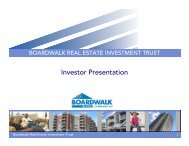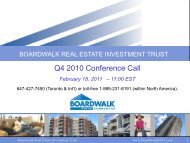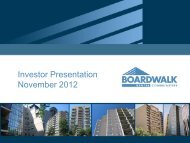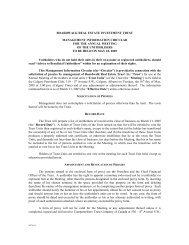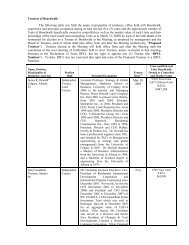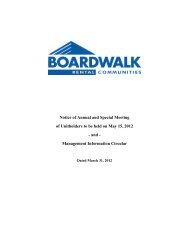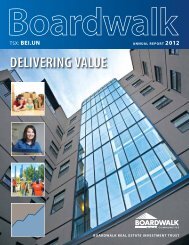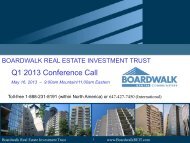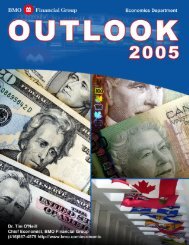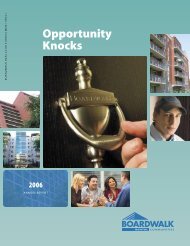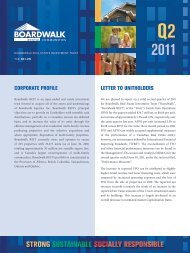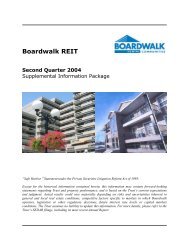BOARDWALK REAL ESTATE INVESTMENT ... - Boardwalk REIT
BOARDWALK REAL ESTATE INVESTMENT ... - Boardwalk REIT
BOARDWALK REAL ESTATE INVESTMENT ... - Boardwalk REIT
Create successful ePaper yourself
Turn your PDF publications into a flip-book with our unique Google optimized e-Paper software.
- 29 -Cost of CapitalIn understanding <strong>Boardwalk</strong> <strong>REIT</strong>‘s investment strategy, it is also necessary to review its cost of capital.The Trust‘s cost of capital is generally defined as the weighted average cost to the Trust of raising incrementalcapital and, accordingly, its hurdle rate for evaluating incremental investments. It can also be thought of as therate of return that the Trust would otherwise be able to earn at the same level of risk. As with most real estateentities, the Trust‘s cost of capital is the combination of its cost of debt and the cost of equity. As will bediscussed in later sections of this AIF entitled ―Managing Capital‖ and ―Liquidity‖, the Trust currently has accessto a low cost of debt through its access to the NHA-insured market. But even this market has different levels ofrisk that are mainly priced through the term selected on the related mortgage. That is, the longer the mortgagefinance term, the longer the borrower is removing the interest rate risk from the investment. It is management‘sview that with respect to those investments where one does not have the benefit of hindsight, for example, withthe actual purchase, ownership and management of a particular building there is an increased level of performancerisk. To moderate this risk, it is necessary to hedge the interest rate risk, by taking a longer-term mortgage toallow for time to better understand the performance risk of the specific property investment. The other majorcomponent in the cost of capital relates to the cost of equity required for the investment. The determination ofthis amount has a number of different models and definitions. However, for simplicity purposes, <strong>Boardwalk</strong>determines its current cost of equity as the amount of FFO reported compared to its current market capitalization.For 2010, the Trust reported FFO per Trust Unit of $2.47. When compared to the simple average Trust Unitmarket price of $40.69 for the month of December 2010, this equates to a cost of equity of approximately sixpercent (6%).Once the Trust has determined its cost of capital, management then analyzes and evaluates theopportunities available to the Trust against a base case scenario. The base case will be determined by answeringtwo distinct questions: 1) is the investment accretive to the Trust‘s implied capitalization rate (―Cap Rate‖)adjusting for related risk, and 2) given the existing leverage of the Trust, is the investment accretive on an FFObasis given its existing portfolio‘s internal growth profile? The investment is also evaluated on a stabilized basis,that is, after considering the impact of funding deferred capital expenditures and leasing up the property. The basecase of the Cap Rate test focuses on the implied Cap Rate of the Trust‘s underlying portfolio as the Trust bestunderstands the operations and risk profile of its own apartment units, and its ability to purchase its own realestate through the use of its current NCIB really does set the base. For an investment to be accretive, it not onlyhas to trade at or above this level, it must also be of equivalent (or better) quality and location. The amount ofexpectation above this base rate is the anticipated risk adjustment rate. Each investment is looked at in isolationand evaluated accordingly. In response to the second question, it is necessary to understand that, historically,multi-family rental real estate has been an investment based on leverage. As such, it is necessary for managementto analyze the underlying ability to obtain debt and the cost of that debt. <strong>Boardwalk</strong> currently does have access toNHA insurance from the Government of Canada, the details of which are discussed later in this AIF under theheading ―Managing Capital‖ and ―Liquidity‖. As with other debt in most instances, the longer the proposed termmaturity, the higher the price for the debt. This difference is the adjustment the market puts on the risk that theinterest rates will be higher during the term of the loan. Accordingly, the investment consideration for the Trustalso adjusts for this risk by building into its current cost of debt a term at the longer end of the curve, usuallyterms ranging between seven (7) and ten (10) years.It is management‘s belief that the Trust‘s investment strategy addresses the key components indetermining whether an investment is accretive for the Trust as a whole. When comparing the externalinvestment opportunity to the Trust‘s internal opportunity of acquiring its own Trust Units for 2010, managementfelt that, on a risk adjusted basis, the better investment was in the Trust‘s own real estate through purchases ofTrust Units on the open market.



